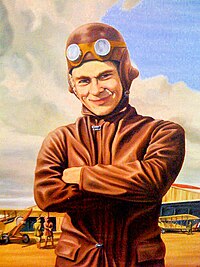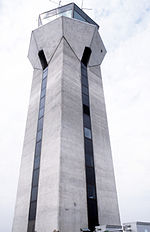Mather Air Force Base
| Mather Air Force Base 323d Flying Training Wing |
|---|
Mather Air Force Base (Mather AFB) was a United States Air Force Base, which was closed in 1993 pursuant to a post-Cold War BRAC decision. It was located 12 miles (19 km) east of Sacramento, on the south side of U.S. Route 50 in Sacramento County, California. Mather Field was one of 32 Air Service training camps established after the United States entry into World War I in April 1917.[1]
The Mather AFB land has various post-military uses including Sacramento Mather Airport, established in 1995. Some of the land was included in the City of Rancho Cordova, when it was incorporated in 2003.[2] Mather Field also now serves as home of the 149th Intelligence Squadron of the 195th Wing, Air National Guard.
History
Mather Air Force Base was named after Second Lieutenant Carl Spencer Mather, a 25-year-old army pilot killed in a mid-air collision while training at
World War I
In January 1918, the
Flight training

Only a few
In 1917, flight training occurred in two phases: primary and advanced. Primary training consisted of pilots learning basic flight skills under dual and solo instruction. After completion of their primary training at Mather, flight cadets were then transferred to another base for advanced training.[3] Training units assigned to Mather Field:[4]
- Post Headquarters, Mather Field April 1918 – November 1919
- 200th Aero Squadron, June 1918 – November 1918 (redesignated as Squadron A, Mather Field July 1918)
- 201st Aero Squadron, June 1918 – November 1918 (redesignated as Squadron B, Mather Field July 1918)
- 283d Aero Squadron (II), April 1918 – November 1918 (redesignated as Squadron C, Mather Field July 1918)
- 294th Aero Squadron (II), June 1918 – November 1918 (redesignated as Squadron D, Mather Field July 1918)
- Squadron E, Mather Field July 1918 – November 1918
- Flying School Detachment (Consolidation of Squadrons A-E), November 1918 – October 1919
With the sudden end of World War I in November 1918, the future operational status of Mather Field was unknown. Many local officials speculated that the U.S. government would keep the field open because of the outstanding combat record established by Mather-trained pilots in Europe. Locals also pointed to the optimal weather conditions in the Sacramento area for flight training. Cadets in flight training on 11 November 1918 were allowed to complete their training, however no new cadets were assigned to the base. The separate training squadrons were consolidated into a single Flying School detachment, because many of the personnel at Mather were being demobilized. Flight training activities finally ceased on 8 November 1919.[3]
Inter-war years
With the end of World War I, in December 1919 Mather Field was closed as an active airfield. However, a small caretaker unit was assigned to the facility for administration. Nonetheless, on 13 December 1919, the United States House of Representatives passed an appropriations bill for $9.6 million for the purchase of additional land at military camps "which are to be made part of the permanent military establishment". Mather Field was allocated $78,000 of this amount.[5]
Mather was used by the aerial forestry patrol. It also was used intermittently to support small military units. However, with the return to a peacetime economy, Mather Field were deemed unnecessary as a military training facility, and it was closed on 12 May 1923. The War Department ordered the small caretaker force at Mather Field to dismantle all remaining structures and to sell them as surplus. Throughout the remainder of the 1920s, the War Department leased the vacant land to local farmers and ranchers.[3]
Mather Field was reactivated on 1 April 1930 as a sub post of the
Note: The airfield served only for aerial forest patrol, beginning 8 January 1919. It was placed on inactive status, 22 June 1922; and closed on 12 May 1923. The airfield was reactivated 1 April 1930; and placed in inactive status, 1 November 1932. It was designated a subpost of the Presidio of San Francisco, unk-13 May 1935; designated a subpost of Hamilton Field, 13 May 1935; designated a subpost of Stockton Field, 21 February 1941.
World War II

The Field was reestablished as a separate post and activated on 13 May 1941. The field area was increased from 872 to 4,418 acres (17.88 km2) in June 1941. Sub-bases and auxiliary fields of Mather included:
- Concord Army Air Field 37°59′24″N 122°03′24″W / 37.99000°N 122.05667°W
- Franklin Auxiliary Airfield (Aux 1) 38°18′13″N 121°25′47″W / 38.30361°N 121.42972°W
- Lincoln Auxiliary Airfield (Aux 2) 38°54′20″N 121°21′03″W / 38.90556°N 121.35083°W
- Winter-Davis Flight Strip (Aux 4) 38°34′48″N 121°51′15″W / 38.58000°N 121.85417°W
- Elk Grove Auxiliary Airfield (Aux 5) 38°25′12″N 121°20′39″W / 38.42000°N 121.34417°W
In 1941 Mather Field became the site for advanced navigator training. The
Mather became a twin-engine Advanced Flying School, training pilots on North American B-25 Mitchell medium bombers. In 1944–45 it became an aerial port of embarkation to the Pacific in preparation for the expected transfer of large numbers of men and aircraft from Europe to the Pacific.[3]
During the summer of 1945, the
Cold War
Air Training Command

During the
The
The 3535th was replaced by the
The 323d continued training USAF navigators, NFOs, NATO/Allied students, and conducting advanced training for radar navigator/bombardiers, electronic warfare officers and weapons systems operators until it was inactivated on 30 September 1993. Concurrent with the wing's inactivation, all USAF navigator and NFO maritime navigation pipeline training was moved to
Radar stations
Mather AFB had a late 1940s/early 1950s Radar Bomb Scoring detachment of the 3903rd Radar Bomb Scoring Squadron.[6]
The Mather AFB general surveillance radar station was established after a second stage of "additional
Strategic Air Command

On 1 April 1958,
Det. 1 320 BW operated at the old bomber alert area at
Concurrent with the inactivation of the 4134th, the
The
Closure



Parts of the airfield were listed on the National Priorities List as a Superfund site on 22 July 1987. The entire site was listed on 21 November 1989.[11] On 30 September 1993, the 5,845 acres (2,365 ha), including 129 acres (522,000 m2) of easements, of Mather AFB was decommissioned under the 1988 Base Realignment and Closure Commission. Most of the base was transferred to Sacramento County, California. Current sites of the former air force base include:
- Sacramento Mather Airport (1995)
- Mather Regional Park
- Veterans Administration Medical Center
- TRACON
- Mather Community Campus, a transitional living facility (1995).
Major commands to which assigned
- Army Air Service, March 1918–22 June 1922
- Army Air Corps, 2 July 1926 – November 1932
- General Headquarters (GHQ) Air Force, 1 March 1935
- Redesignated: Air Force Combat Command, 20 June 1941
- Air Corps Flying Training Command, 23 January 1942
- Redesignated: AAF Flying Training Command, 15 March 1942
- Redesignated: AAF Training Command, 31 July 1943
- Air Transport Command, 1 October 1944
- Army Air Force Training Command, 20 December 1945
- Redesignated: Air Training Command, 1 July 1946
- Redesignated: Air Education and Training Command, 1 July-1 October 1993
Major units assigned
|
|
Source for major commands and major units assigned:[12][13]
Natural history
There are rare wetland
See also
- California World War II Army Airfields
- 35th Flying Training Wing (World War II)
- List of USAF Aerospace Defense Command General Surveillance Radar Stations
- List of Training Section Air Service airfields
References
![]() This article incorporates public domain material from the Air Force Historical Research Agency
This article incorporates public domain material from the Air Force Historical Research Agency
- ^ William R. Evinger: Directory of Military Bases in the U.S., Oryx Press, Phoenix, Ariz., 1991, p. 147.
- ^ "Cordova Community Plan" (PDF). Sacramento County Board of Supervisors Resolution No. 2003-0551. 23 April 2003. Archived (PDF) from the original on 2 February 2017. Retrieved 14 November 2016.
- ^ ISBN 0738588776
- ^ Order of Battle of the United States Land Forces in the First World War, Volume 3, Part 3, Center of Military History, United States Army, 1949 (1988 Reprint)
- ^ United Press, "House Passes Bill To Buy March Field", Riverside Daily Press, Riverside, California, Saturday evening, 13 December 1919, Volume XXXIV, Number 269, page 8.
- Bulletin Board). KoreanWar.org. Retrieved 20 May 2012.
Served…from October, 1957 to June, 1962. …Keesler AFB for tech school, then…at Los Angeles RBS site
- ISBN 0-912799-60-9. Retrieved 26 September 2011.
- ^ Professional-was assigned alert duty there in the 1980s.
- ^ 320th Air Expeditionary Wing#320th Bombardment Wing (Cold War)
- ^ 940th Air Refueling Wing
- ^ "Mather Air Force Base Superfund site progress profile". EPA. Archived from the original on 16 June 2011. Retrieved 26 April 2010.
- ISBN 0-912799-53-6
- ISBN 1-85780-197-0.
- ^ "The Vernal Pools of Mather Field – Sacramento Splash". sacsplash.org. Archived from the original on 24 March 2013. Retrieved 30 April 2018.
- ^ C. Michael Hogan. 2009. Yellow Mariposa Lily: Calochortus luteus, GlobalTwitcher.com, ed. N. Stromberg Archived 4 October 2011 at the Wayback Machine
- ^ "Plants of Mather Field". vernalpools.org. Archived from the original on 3 March 2016. Retrieved 30 April 2018.
- ^ "Field Guide to the Vernal Pools of Mather Field, Sacramento County". cnps.org. Archived from the original on 27 February 2014. Retrieved 30 April 2018.
- Maurer, Maurer. Air Force Combat Units of World War II. Washington, DC: U.S. Government Printing Office 1961 (republished 1983, Office of Air Force History, ISBN 0-912799-02-1).
- Ravenstein, Charles A. Air Force Combat Wings Lineage and Honors Histories 1947–1977. ISBN 0-912799-12-9.
- Mueller, Robert (1989). Volume 1: Active Air Force Bases Within the United States of America on 17 September 1982. USAF Reference Series, Office of Air Force History, United States Air Force, Washington, D.C. ISBN 0-16-002261-4



